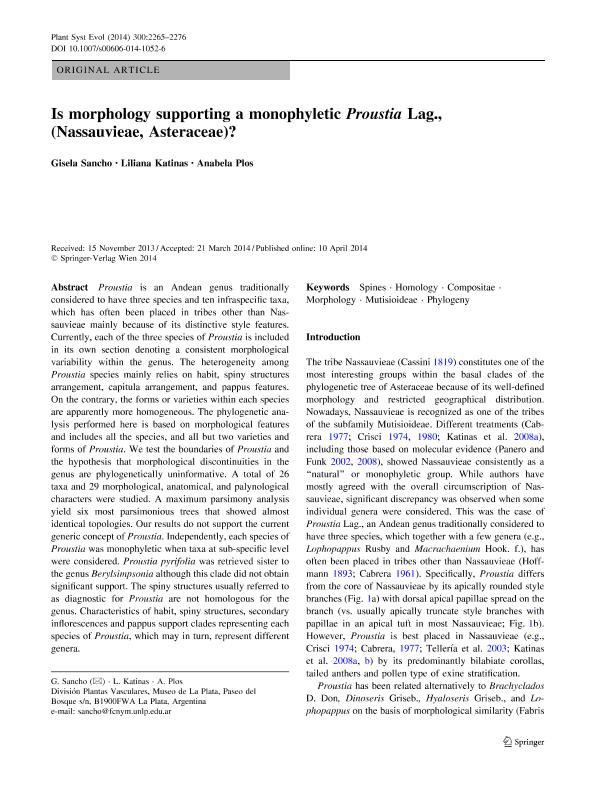Artículo
Is morphology supporting a monophyletic Proustia Lag., (Nassauvieae, Asteraceae)?
Fecha de publicación:
04/2014
Editorial:
Springer Wien
Revista:
Plant Systematics and Evolution
ISSN:
0378-2697
Idioma:
Inglés
Tipo de recurso:
Artículo publicado
Clasificación temática:
Resumen
Proustia is an Andean genus traditionally considered to have three species and ten infraspecific taxa, which has often been placed in tribes other than Nassauvieae mainly because of its distinctive style features. Currently, each of the three species of Proustia is included in its own section denoting a consistent morphological variability within the genus. The heterogeneity among Proustia species mainly relies on habit, spiny structures arrangement, capitula arrangement, and pappus features. On the contrary, the forms or varieties within each species are apparently more homogeneous. The phylogenetic analysis performed here is based on morphological features and includes all the species, and all but two varieties and forms of Proustia. We test the boundaries of Proustia and the hypothesis that morphological discontinuities in the genus are phylogenetically uninformative. A total of 26 taxa and 29 morphological, anatomical, and palynological characters were studied. A maximum parsimony analysis yield six most parsimonious trees that showed almost identical topologies. Our results do not support the current generic concept of Proustia. Independently, each species of Proustia was monophyletic when taxa at sub-specific level were considered. Proustia pyrifolia was retrieved sister to the genus Berylsimpsonia although this clade did not obtain significant support. The spiny structures usually referred to as diagnostic for Proustia are not homologous for the genus. Characteristics of habit, spiny structures, secondary inflorescences and pappus support clades representing each species of Proustia, which may in turn, represent different genera.
Palabras clave:
Spines
,
Phylogeny
,
Morphology
,
Mutisioideae
,
Homology
,
Compositae
Archivos asociados
Licencia
Identificadores
Colecciones
Articulos(CCT - LA PLATA)
Articulos de CTRO.CIENTIFICO TECNOL.CONICET - LA PLATA
Articulos de CTRO.CIENTIFICO TECNOL.CONICET - LA PLATA
Citación
Plos, Anabela; Sancho, Gisela; Katinas, Liliana; Is morphology supporting a monophyletic Proustia Lag., (Nassauvieae, Asteraceae)?; Springer Wien; Plant Systematics and Evolution; 300; 10; 4-2014; 2265-2276
Compartir
Altmétricas




